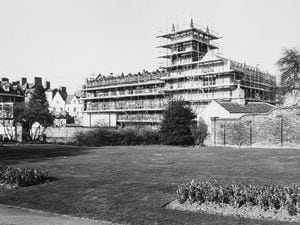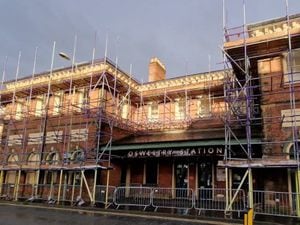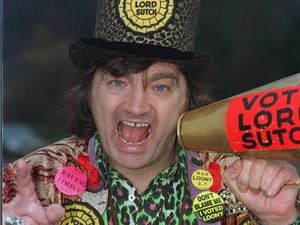100 years of the RAF
1918
Second Lieutenant Charles McElroy Carpenter, aged 21, took off from Shawbury airfield, did some firing practice, and then seemed to lose control of his Sopwith Camel and nose-dived into the ground.
He was buried in the churchyard at Shawbury - Shropshire's last Royal Flying Corps victim. Because within a fortnight of that crash on March 21, 1918, the RFC was no more - and the Royal Air Force was born.
Carpenter was typical of young airmen from around the world who came to Shropshire in the Great War. His home address was given as 6 East Lake Street, Chicago - he worked in the American city - but he was in fact a Canadian.
Shawbury was one of three Great War air bases in Shropshire, with Tern Hill being the oldest of all, receiving squadrons in December 1916. Flying training at Shawbury began in 1917, while Monkmoor airfield opened in 1918 as home for the Observers School of Reconnaissance and Aerial Photography.
...................................
1920s
And then there were none. As fast as the aerodromes had appeared, they disappeared - and remember that in those days airfields were just that, expanses of grass, and the hangars might be canvas affairs and the huts wooden.
Shawbury returned to agriculture. Two hangars at Tern Hill were used at stabling and a third for indoor schooling of horses, while the airfield itself was used as a gallops.
The military sold hangars and buildings at Monkmoor in 1922, although there was civilian flying from the airfield in the 1920s and 1930s, when it was used for pleasure flights.
Today the Monkmoor flying field is covered with housing, but two original Great War hangars remain, although only just, as in 2016 there were proposals to demolish them to make way for new homes. The plans were turned down after objections on the grounds of their heritage value.
.......................
1930s
As the decade progressed, so events on the international stage became increasingly ominous. It was time to reactivate those airfields.
Those created in the 1930s - reborn Shawbury, reborn Tern Hill, and a completely new site at Cosford - were positively palatial compared with the Great War airfields, with handsome brick-built accommodation, large permanent hangars, and various creature comforts for the personnel.
The flying fields themselves were still grass. Tern Hill and Shawbury were involved in flying training and maintenance while in the summer of 1938 Cosford received the first of many thousands of technical trainees, just one of many roles that base was to perform.
Then came the outbreak of war...
....................
1940s
Suddenly, in 1940 and 1941, all was transformed. From being a relative backwater where training roles could be performed safely, the RAF in Shropshire was pitched into the front line, as Luftwaffe bombers roared overhead during the Blitz.
Fighter squadrons stationed at High Ercall and Tern Hill racked up a number of enemy "kills."
Marauding Spitfires, Hurricanes, Beaufighters, Defiants and Blenheims scoured the Shropshire skies. But it was not all one way. Several RAF bases in Shropshire were bombed and a Beaufighter which crashed at Poynton Green was found to have bullet holes in it.
As part of the training for bomber crews in Shropshire, they would be sent on dangerous missions over enemy-held territory to drop propaganda leaflets. Giant Stirling and Halifax bombers were familiar sights, being used as part of the training for parachute and glider-borne assaults such as the Arnhem operation, in which aircraft based at RAF Tilstock, near Whitchurch, took part, albeit flying from airfields in the south of England.
And we have still only scratched the surface of the RAF's wartime role. But we'd better mention RAF Bridgnorth, which opened in November 1939 and gave thousands of recruits their initial training.
Above all, the war changed the Shropshire landscape, with many new air bases, big and small, springing up for the war effort. We may as well list them: Atcham, Bratton, Bridleway Gate (near Preston Brockhurst), Brockton (near Sutton Maddock), Chetwynd, Condover, Cosford (opened pre-war), High Ercall, Ollerton (taken over by the Royal Navy as Royal Naval Air Station Hinstock), Hodnet, Monkmoor (used for salvage of crashed aircraft), Montford Bridge, Peplow, Rednal, Shawbury (opened pre-war), Sleap, Tern Hill (opened pre-war), Tilstock, and Weston Park.
.............
1950s
Unlike the aftermath of the Great War, Shropshire farmers had to wait for ages to get their requisitioned land back - if they ever did.
The advent of the Cold War meant the military was in no hurry. Nevertheless the number of active military airfields dwindled from their wartime numbers, but those that remained continued to be vital cogs in the nation's military machine.
RAF Shawbury had become home for the Central Navigation School in 1944 and in 1950 air traffic control training arrived. In the late 1950s the main runway was substantially lengthened southwards so that the base could act as a diversion airfield for V-bombers.
Many young airmen and women in the RAF did their training at RAF Cosford, which continued its role as a major ground training station. Tern Hill had a training and repair role, while over at High Ercall the last planes at 29 Maintenance Unit left in February 1957.
.......................
1960s
Chop, chop - the helicopters are coming.
While the jet age had not exactly bypassed Shropshire, the 1960s were to see the advent of helicopters which continue to be the most familiar RAF flying role in the county today.
Alas, it was not a good start because the Bristol Sycamore was a mediocre helicopter with significant flaws. Some of those flying from the Central Flying School at Tern Hill were involved in fatal crashes. In 1966 Sycamores at the base were grounded in the wake of three accidents in quick succession.
There were superseded by the Westland Whirlwind, based on an American design.
RAF Bridgnorth, which had been the first point of call for thousands of new recruits, closed on February 8, 1963.
And RAF Shawbury was given the Freedom of the Borough of Shrewsbury in March 1968.
.............
1970s
Some big goodbyes in this decade.
Goodbye in December 1977 to RAF Cosford Hospital, which despite being a military hospital, 70 per cent of those treated were civilians.
And farewell to RAF Tern Hill. On September 29 its helicopters flew to their new home at RAF Shawbury. The accommodation part of Tern Hill was handed over to the Army, officially opening as Clive Barracks on July 1, 1980.
There were new beginnings as well. Helicopters at Shawbury, for instance.
An open day and air display at RAF Cosford in 1978 to mark the 60th anniversary of the RAF is seen as the start of the modern Cosford air show.
Also at Cosford, an aerospace museum opened to the public for the first time on April 6, 1975 - this most have been a forerunner of the modern museum, as Cosford's website gives a date of May 1, 1979.
.........................
1980s
One feature of RAF Shawbury that may not be fully appreciated is its status as a royal gateway to the county.
This decade was typical, with royalty dropping in on a number of occasions.
For example, in May 1980 Princess Margaret and UN Secretary General Dr Kurt Waldheim arrived on their way to Keele University. Only a month later Princess Margaret was flown in to the air base by a distinguished pilot - Prince Charles - on an engagement to open officially Shawbury’s new scout and guide centre.
We won't go through all the other royal occasions, but will mention that in June 1983 the Queen Mother paid a private visit, and that the Queen arrived through Shawbury on her way to a private visit to COD Donnington in June 1982.
As to what Shawbury and Cosford were doing in the 1980s, it was the same as always - training, training, training.
.........................
1990s
Another thing that might be overlooked about the RAF's role in Shropshire is in the sporting arena.
The indoor athletics arena at Cosford had hosted some of the greatest stars of their day, like Sebastian Coe, Steve Ovett, Michael Johnson, Linford Christie, and Zola Budd.
The banked track was laid out in a hangar in 1961, although a flat track in an adjacent hangar had been in use for some years previously.
Meetings were often televised. However, the last top class event was in February 1991 and the last meet of all was the British veterans’ championships in March 1993.
The fall of the Berlin Wall meanwhile brought a peace dividend which threw a question mark over the role of Shropshire's remaining air bases, so there was considerable relief when it was announced on October 1, 1996, that Britain’s sole military helicopter flying school was to be based at RAF Shawbury.
................
2000s
Interesting times.
In 2009 RAF Shawbury had its most famous trainee pilots of all. Princes William and Harry were under instruction at the Defence Helicopter Flying School.
William was training to become an RAF search and rescue pilot while his younger brother Harry was aiming to become a pilot with the Army Air Corps.
Over at Cosford, there was a great expansion with the Princess Royal opening the National Cold War Exhibition at the RAF Museum there in 2007.
But for the RAF base itself, it was a rollercoaster ride of a decade with whispers about its future.
It was announced that it had lost out to RAF St Athan in South Wales for a contract worth £14 billion to become a national super centre for training. But later that plan was axed.
It was similarly announced that soldiers returning from Germany would be relocated at the base by 2014. That didn't happen either.
.......................
PRESENT DAY
What's happening at Shawbury today? We can do no better than quote from the official website: "RAF Shawbury in Shropshire trains around 1,000 students a year from across the UK armed services and international partners to be robust, resilient military personnel, technically second to none.
"The Defence Helicopter Flying School trains aircrew for the RAF, Royal Navy and British Army. The Central Flying School (Helicopter) delivers the next generation of helicopter instructors.
"The School of Air Operations Control trains the next generation of controllers, delivers training to those about to deploy on operations, and trains selected personnel as instructors.
"There are approximately 1,200 personnel working at RAF Shawbury, around 500 service personnel supported by MOD civilian and contractor colleagues."
And Cosford? "RAF Cosford in Shropshire is a major part of the Defence College of Technical Training. It is at the centre of the RAF’s mission to deliver flexible, affordable, modern and effective technical training that meets the needs of the UK’s armed forces now and into the future.
"RAF apprenticeships delivered at RAF Cosford were recently recognised as ‘Outstanding’ by Ofsted.
"RAF Cosford is also home to the popular RAF Museum and the world-renowned Cosford Airshow."
One hundred years on from the birth of the RAF, Shropshire is continuing to be a key player.





